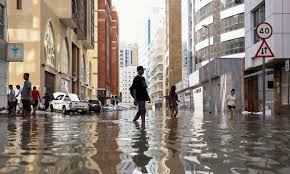DUBAI: Dubai, a city in the desert proud of its modern gloss, faced the towering task on Thursday of clearing its waterclogged roads and drying out flooded homes two days after a record storm saw a year’s rain fall in a day. Dubai International Airport, a major travel hub, struggled to clear a backlog of flights and many roads were still flooded in the aftermath of Tuesday’s deluge.
The rains were the heaviest experienced by the United Arab Emirates in the 75 years that records have been kept. They brought much of the country to a standstill and caused significant damage.
Many reported leaks at their homes, while footage circulated on social media showed malls overrun with water pouring from roofs.
In Dubai, traffic remained disrupted even as public transportation services resumed. Street closures, detours and partially submerged roads caused heavy congestion, with some cars driving towards oncoming traffic in effort to avoid flooded areas.
A highway through Dubai was reduced to a single lane in one direction, while the main road that connects Dubai with the capital Abu Dhabi was partially closed in both directions.
“This was like nothing else. It was like an alien invasion,” Jonathan Richards, a Dubai resident from Britain told reporters.
“I woke up the other morning to people in kayaks with pet dogs, pet cats, suitcases all outside my house.” Another resident, Rinku Makhecha, said the rain swamped her freshly renovated house she moved into two weeks ago.
“My entire living room is just like … all my furniture is floating right now,” she said.
Vehicles, including buses, were abandoned on streets and some could be seen submerged in water. In Abu Dhabi, some supermarkets and restaurants faced product shortages, unable to receive deliveries from Dubai.
Dubai airport had yet to resume normal operation after the storm flooded taxiways, forcing flight diversions, delays and cancellations.
Dubai Airports Chief Operating Officer Majed Al Joker told Al Arabiya TV he expected Dubai International Airport to reach 60-70% capacity by the end of Thursday and full operational capacity within 24 hours.
The airport struggled to get food to stranded passengers with nearby roads flooded and overcrowding limited access to those who had confirmed bookings.
The storm, which hit neighbouring Oman on Sunday, pounded the UAE on Tuesday, with 20 reported dead in Oman and one in the UAE.
While some roadways into hard-hit communities remain flooded, delivery services across Dubai, whose residents are used to ordering everything at the click of a mouse, slowly began returning to the streets.
Rains are rare in the UAE and elsewhere on the Arabian Peninsula, which is typically known for its dry desert climate.
Summer air temperatures can soar above 50 degrees Celsius.
Following Tuesday’s events, questions were raised whether cloud seeding, a process that the UAE frequently conducts, could have caused the heavy rains.
But climate experts blame global warming for such extreme weather events.
Researchers anticipate that climate change will lead to heightened temperatures, increased humidity and a greater risk of flooding in parts of the Gulf region. Countries like the UAE where there is a lack of drainage infrastructure to cope with heavy rains can suffer the most.
A UAE government agency that oversees cloud seeding – a process of manipulating clouds to increase rainfall – denied conducting any such operations before the storm.
President Sheikh Mohammed bin Zayed Al Nahyan said in a statement he had ordered authorities to assess the damage and provide support to families impacted by the storm.
Dubai’s Crown Prince Sheikh Hamdan bin Rashid Al Maktoum said on X that the safety of citizens, residents and visitors was the utmost priority.
“At a meeting with government officials in Dubai, we set directives to prepare comprehensive plans in response to natural crises’ such as the unexpected current weather conditions,” he said.


